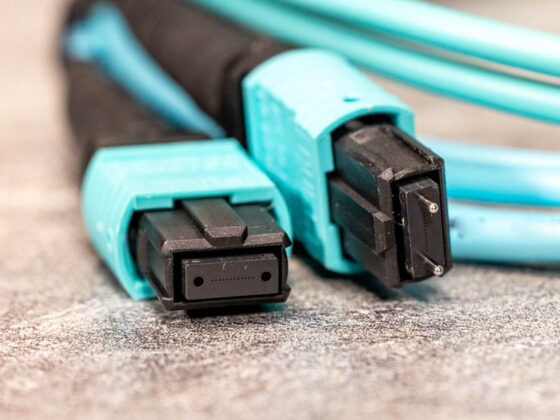Optical Fiber Types
There are the 5 types of multimode fiber currently on the market.

OM1 and OM2, the original 62.5 micron (µm)- and 50 µm-diameter types, respectively, are considered obsolete in the ISO/IEC 11801 and TIA 568 standards, and no longer included in the main text of the documents. They are, however, allowed as grandfathered fiber types and may be used to extend legacy networks. New installations should use OM3, OM4 or OM5 multimode fiber types.
OM3 multimode, introduced in 2003, was the first fiber designed for use with laser light sources at 850 nanometers (nm), primarily to support 1 and 10 Gb/s operation. OM4, standardized in 2009, offers longer link lengths, supporting 10 Gb/s operation to 400 m in the standard, and up to 550 m using some engineering rules.
An even more recent innovation was the introduction in 2017 of OM5, known as “wideband” multimode fiber. Traditionally, multimode fiber has operated at a single wavelength. When higher network speeds were needed, lasers were developed that would operate at these speeds. This approach worked very well up to 10 Gb/s and, later, 25 Gb/s. In order to increase speeds further, however, parallel fiber systems were introduced, first for 40 Gb/s, then for 100 Gb/s. Four fibers, or lanes, were used to support these higher speed links.
OM5 fiber is the first multimode fiber designed to support multiple wavelengths. It enables duplex transmission of 100 Gb/s using either two or four wavelengths between 850 and 950 nm. This is done while taking advantage of multimode fiber’s longer wavelength transmission properties. The fiber’s lower chromatic dispersion at longer wavelengths means that modal bandwidth requirements could be relaxed at those longer wavelengths.
Optical Fiber FAQs
Are there any special requirements for the optical fiber used in passive optical LAN?
Each ONT end device just requires one strand of single mode fiber. And the connectors typically used in passive optical LAN are SC/APC angle polish connectors. Note: some manufacturers now offer a way to leverage multimode fiber in applications where the fiber plant was already installed.
Are there any special requirements for the optical fiber used in passive optical LANs?
In a Passive Optical LAN each ONT end device requires one strand of single-mode fiber. The connectors typically used in passive optical LAN are SC/APC angle polish connectors on the end. If you have existing single mode in your backbone, then you’re halfway there.
Does a Passive Optical LAN (POL) use multimode or single-mode fiber?
Passive optical LAN (POL) architectures primarily use single-mode fiber because of the medium’s high capacity and ability to support long link lengths — up to 20 km. In a POL architecture. In a POL, a passive single-mode fiber network runs down to the desktop, through an optical splitter and into a thin-client edge device or Optical Network Terminal (ONT). Recently single-mode to multimode optical splitters have been introduced that enable cost-effective re-use of existing multimode fiber cabling for Passive Optical LANs inside buildings and across a campus.
What fiber is typically being used with the 200 400 Gig circuits?
Most likely you are looking at either OM4 or OM5 multimode fibers. Of course single mode will always be an option, but on the multimode side you have OM5 fiber, which is optimized for the short wave division multiplexing (SWDM) so depending on the distances you need to support, those to fiber types will give you the most cost effective solution.
What is Wavelength Division Multiplexing (WDM) Technology?
Wavelength division multiplexing (WDM) allows multiple wavelengths, typically 2 or 4 wavelengths over a single fiber. The IEEE 802.3bs 200 Gb/s & 400 Gb/s Ethernet Task Force in 2016 added 200 Gb/s capability to support a cost and performance optimized migration path to 400 Gb/s that includes support for 200 Gb/s with at least 2 km of SMF (4l WDM duplex fiber) and at least 10 km of SMF (4 l WDM duplex fiber).
What changes were made to ANSI/TIA-942 when it was updated in 2017?
Some important changes to TIA-942-B Data Center Standard include:
- Added MPO-16, MPO-32 (ANSI/TIA-604-18) and MPO-24 (ANSI/TIA-604-5)
- Added Category 8
- Changed recommendation to category 6A or higher
- Added wideband laser-optimized 50/125 µm multimode (OM5)
- Added 75-ohm broadband coaxial cables and connectors (ANSI/TIA-568.C-4)
- Added recommendations for fiber in non-continuous pathways that could cause micro bends
- Recommends that cabinets be at 1200 mm (48”) deep and to consider cabinets wider than 600 mm (24”) wide
- Recommends considering pre-terminated cabling to reduce installation time and improve consistency and quality of terminations
- Recommends considering need for proper labeling, cable routing, cable management, and ability to insert and remove cords without disrupting existing or adjacent connections
- Maximum cable lengths for direct attach cabling in EDAs reduced from 10 m (33 ft.) to 7 m (23 ft.). (Direct attach cabling between rows is not recommended).
Other relevant changes include:
- Change in return loss for single-mode fiber from minimum 26dB to minimum of 35dB, making field terminations more difficult
- Polarity in Testing; used to be covered in ANSI/TIA -568.0-D and now is addressed in 568.3-D.
What type of fiber do you recommend for data center applications?
To support the high bandwidths required in data centers, most companies are installing at least OM4, laser optimized multimode fiber. Some companies are installing single-mode fiber, but that requires more expensive optics. A new option that is emerging is OM5, a wide bandwidth multimode fiber which allows short wavelength division multiplexing. This means the fiber can carry multiple wavelengths of light over the same fiber, increasing bandwidth significantly and yet still allowing the use of lower cost multimode optics.
What is wide band multimode fiber and how is it used?
WBMMF is a relatively new fiber medium specified in ANSI/TIA-492AAAE and given the designation of OM5 multimode fiber by ISO/IEC and TIA. This 50/125 µm multimode laser optimized fiber was originally developed to support Short Wavelength Division Multiplexing (SWDM) and supports 4 wavelengths of 25Gb/s transmission for an aggregated 100 Gb/s transmission on a duplex LC link, a popular and familiar interface in the data center. WBMMF supports four wavelengths between 850 nm and 953 nm, using multimode optics. WBMMF was designed for use in data centers.
Should I install singlemode or multimode fiber in my network?
While some people choose to install singlemode fiber because of it’s high bandwidth, multimode fiber continues to be a popular choice for enterprise applications. Newer grades of multimode fiber, such as OM4 laser optimized fiber and OM5, wideband multimode fiber, have the bandwidth to support most applications over the distances required, plus the cost for the optics remains lower than the cost of singlemode optics.
Are Bend Insensitive Multimode Fiber approved by standards?
Yes. ANSI/TIA/EIA-568B.3 sets performance specifications, minimum bend radius standards and maximum pulling tensions for 50/125-micron and 62.5/125-micron fiber optic cables. For inside plant cable, the fiber cable bend radius is 10 times the cable’s outside diameter under no pull load, and 15 times the cable’s outside diameter when subject to tensile load performance measurements and qualification processes. If you are interested learning more about the status of BIMMF or participating in the discussion you can access the schedule for TR-42.12 here and download recent meeting reports.
RECENT WEBINARS
-

The Perpetual Perplexities of Optical Fiber Polarity
Optical Fiber Polarity is an essential design and implementation process necessary to ensure the proper functioning of all optical networks.…Read more -

Tales from the Field: The Top 5 Mistakes and How to Avoid Them
This presentation addresses some of the most common mistakes we see in the field and how to avoid them. Topics…Read more -

TIA-942-C Data Center Standard: What’s New?
The recent revision to ANSI/TIA-942-C addresses the evolving needs and challenges of modern data center infrastructure by incorporating new technologies…Read more -

LAN Standards, News & Trends: 2024 Update
Join FOTC Standards Chair Cindy Montstream for our annual standards update on June 27. This comprehensive session covers relevant IEEE…Read more
RECENT ARTICLES
-

Artificial Intelligence Needs Glass
With large language models that power systems like ChatGPT increasing in popularity – the AI text-generating website saw 1.6 billion…Read more -

Connecting the future—from cloud to edge
All around us, technology is rapidly evolving, and its capabilities are continuing to become a part of everyday life. Advanced…Read more -

5 things you need to know about multifiber push-on connector testing
With increased service demand is driven by an uptick in teleworking, distance learning, and online socializing trends, reliable network connectivity…Read more -

TIA Standard adds MPO Test Requirements and Procedures
In its latest revision (September 2022), the Telecom Industry Association (TIA) added MPO test requirements and procedures to their optical…Read more
